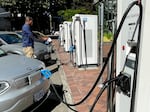
JR Anderson, program manager for Forth, views charging stations in Portland's Electric Avenue, Sept. 8, 2022. Anderson recently bought a 2022 Chevy Bolt and says it is one of the more affordable EVs, qualifying for both the federal and state rebates.
Monica Samayoa / OPB
Ellen Valarida spent two years researching her perfect electric vehicle before buying a used 2019 Nissan Leaf in May for about $35,000. The 32-year-old ride-share driver from Salem said owning an EV has been life changing but it hasn’t always been easy.
“Some challenges that I’ve experienced (include) the charging times and the range for my vehicle, having enough charging ports to be able to charge it,” she said.
Valarida said she can’t afford an upgraded home charger so she relies on public charging stations. But they’re hard to find near her home and work, an issue advocates say is impacting accessibility for many low-income households and communities of color.

Ellen Valarida, a 32-year-old ride-share driver from Salem, said owning an EV has been life-changing but it's not easy.
Courtesy of Ellen Valarida
She’s not alone.
As more electric vehicles are hitting the road, a national report says there’s high interest from all racial demographic groups in purchasing EVs. But barriers like affordability, demand and access to charging stations have created a gap for rural, low-income and communities of color to get access to these vehicles. A 2021 report from the Oregon Department of Energy showed 78% of registered EVs are in areas with less diversity. The agency does not have owner specific racial demographics and instead used U.S. Census data to gather results.
To make EVs available to a wider range of people in Oregon, state agencies and local advocates are taking charge.
Oregon Clean Vehicle Rebate Program
In late 2018, the Oregon Department of Environmental Quality began issuing cash rebates through its newly implemented Oregon Clean Vehicle Rebate Program to qualified drivers who purchase or lease an electric vehicle. The program is designed to encourage drivers to purchase EVs, reduce air pollution and help the state meet its emissions goals. An agency report found the transportation sector accounted for 40% of the state’s total greenhouse gas emissions, making it the largest single source in the state.
The program offers two cash rebates — the Standard Rebate Program and the Charge Ahead Rebate. DEQ’s Senior Air Quality Advisor Rachel Sakata said qualifying Oregonians could stack rebates and get up to $7,500 off a new electric vehicle, which she said would help low-to-moderate income households have better access to these cars.
Those rebates are especially important because inflation helped drive the average price of an EV to $66,000 this summer. That’s a more than 13% increase in just the last two years.
“What we’re seeing is that with the current supply challenges, vehicles are just more expensive overall,” she said. “This rebate is out there to help defray those costs.”
According to DEQ, there are more than 50,000 EVs currently registered in Oregon. So far, more than $55 million has been awarded through the programs, with $14 million awarded this year. According to early 2021 data, the average recipient of the EV Charge Ahead rebate had a household income of $66,265. For used EV rebate recipients, the average income was $53,945. According to U.S Census data, the median household income for Oregonians in 2020 was $65,667.
With the recently signed Inflation Reduction Act, starting next year qualified households with low-to-moderate income get up to $7,500 in federal tax credits for a new electric vehicle or $4,000 for a used one. Sakata said that means qualifying Oregonians could get a total of up to $15,000 off a new electric vehicle purchase.
Despite the success of the program, participation from low income and communities of color households is on the lower end of what Sakata said she would like to see. She said the agency is required to ensure 20% of its $12 million in funding from a tax on car dealers is set aside for the Charge Ahead Rebate program — which applies to households that make $51,000 to $251,000 a year depending on the household size. Those who qualify can get up to $5,000 in rebates for purchasing or leasing a new or used battery electric or plug-in hybrid vehicle.
Data collected by DEQ from a voluntary survey response earlier this year shows nearly 83% of applicants from both the Standard rebate and Charge Ahead rebate programs identified as white. Black and Latino applicants accounted for almost 10% of rebates combined.
Sakata said she’s hopeful the program will reach its goal of 20% this year.
“But you know, 20% to me is still too low,” she said.
Sakata said she believes low participation from these communities stems from a lack of familiarity with EVs.
“The message matters, it needs to come from within the community,” she said. “So, one of the things that we’re going to be doing this upcoming year is working directly with community-based organizations because you know, there’s trust within the community.”
Sakata said DEQ has tried to reduce barriers by doubling the amount of the rebate for the Charge Ahead Program. The agency is also working on making that rebate available at the point of purchase rather than waiting more than two months for processing. That’s something Valarida is dealing with now. Because of her annual income, she qualified to receive $5,000 back from the state but she hasn’t received it yet despite buying her car in May.
DEQ is also expanding its outreach within these communities and recently hired a new team to help answer questions.
That’s something Forth, a nonprofit dedicated to increasing equitable access to electric transportation, has been working on for years.
The messenger matters
JR Anderson has been teaching people about EVs as a program manager for Forth Mobility, which holds Mobile Showcase events in rural and traditionally underserved communities. The events educate people about EVs and let them test drive vehicles. It’s where Valarida first learned about an EV more than two years ago. Recently, Anderson bought a 2022 Chevy Bolt for the test drives because it’s one of the more affordable EVs and qualifies for both the federal and state rebates.

JR Anderson helps operate Mobile Showcase events in rural and traditionally underserved communities.
Monica Samayoa / OPB
Anderson said he gets a lot of questions — from affordability to reliability to learning to live with an EV and range.
“I think the biggest thing is range anxiety,” he said. “I think cars are now more capable and so you don’t have to deal with range anxiety as much.”
But he said barriers for low-income and communities of color go beyond these concerns, the main one being educating people about EVs from a trusted source.
“We’re reaching out to areas in rural Oregon and potentially Washington state to educate people and find out what their barriers are,” he said. “The challenge is, trying to get in front of BIPOC communities. So that’s really what I’m focused on, trying to get in front of those people.”
Anderson said Forth is working on ways to help spread the word about EVs, including through the Portland Clean Energy Fund. Forth and Hacienda CDC will be partnering over the next three years on a $3.6 million Green Energy and Mobility project. Hacienda CDC, a nonprofit that develops affordable housing in Portland, has been partnering with Forth for more than 10 years. So far, Hacienda CDC has about 600 affordable housing units and will be opening an additional 142 units across the street from its headquarters in their newest building — Las Adelitas.
Resident services manager Jessica Lam said the partnership will create a new car-sharing program that will involve piloting an EV shuttle service.
“We’re hoping that having that shuttle will not only promote green energy or electric vehicles but also give families opportunities to go to places that might be difficult for them to get to,” she said.
A few years ago, Hacienda CDC piloted a community car-sharing program that allowed residents to rent out an EV.
But Lam said there were many barriers to access, including using an app to reserve the car on a smartphone, language barriers, having a bank account to pay for the service, and the fear of using an unknown car. Hacienda CDC ultimately decided it was best to end the program until they could figure out a better way to educate the community and get people better access to EVs.
“So, there was just a multi-layer of hurdles that folks had to get through, which made it inaccessible,” she said.
Down the line, Lam said Hacienda CDC hopes to bring back EVs for their residents to rent but will figure out different ways of doing so. Hacienda CDC also plans to install two charging stations at their newest building at Las Adelitas through their partnership with Forth, to remedy another issue people face — keeping their EV charged.
Rethink charging
People like Valarida go through hoops to be able to find the perfect time and rates to charge their cars and stay under budget. Some people can buy level 2 chargers for their homes, which can triple the amount of charge per hour depending on the charger, but they could cost several hundred dollars to thousands. For people like Valarida on a budget, buying both an EV and a new charger could be out of reach.

Ellen Valarida of Salem recently bought a used 2019 Nissan Leaf for $35,000. Because of her income, she's qualified to receive a $5,000 rebate through the Oregon Department of Environmental Quality's program.
Courtesy of Ellen Valarida
Other challenges emerge for people who live in apartment complexes and multi-dwelling housing like 36-year-old Monica Zazueta. She lives in low-income housing in Vancouver and needs to ensure her parking space is close to her apartment so that her charging cord can reach a power outlet. She said she tried asking her apartment managers for help and tried switching her parking spot, but the other person wasn’t willing to give it up.
“We need charging stations in low-income housing communities,” she said. “This should never happen to anyone again. This was such a horrible experience. I don’t wish this upon anybody. That’s totally going to hurt people from wanting to get an EV.”
But using this method, known as level 1 charging, is the slowest and least efficient way to charge an EV. Usually level 1 chargers get up to five miles of charge per hour, meaning it could take 24 hours or longer to get a full charge depending on the car’s battery.
That’s one of the issues the Oregon Department of Transportation is working on addressing. The agency is set to invest $100 million to build out fast-charging infrastructure along the state’s major roadways over the next five years.
ODOT spokesperson Matt Noble said about $36 million will be focused on filling the gaps in disadvantaged communities and rural communities. He said $4 million will go toward a new community EV charging rebate program that will reimburse entities up to 75% of the cost of buying and installing an EV charging station. That program is set to start next year.
That means apartment complexes like Zazueta’s, or multi-unit dwellings, local businesses, recreation areas or shopping centers can purchase charging stations and get money back. Noble said this is one of the barriers that needs to be addressed now so it doesn’t snowball into larger problems.
“It’s really about how can we help communities install charging where it traditionally hasn’t been, especially in more rural parts of the state and also in our disadvantaged communities here in Oregon,” he said.
Another way ODOT will be prioritizing disadvantaged communities is by using an interactive map of proposed charging stations. Noble said ODOT will not be building out the infrastructure but rather partner with private companies and ask them to prioritize the most desired and needed locations first. The agency currently has an interactive map to use as a survey to show where Oregonians would like to see these chargers go.

A map of potential charging stations Oregonians have proposed for the Oregon Department of Energy to look into as it plans to invest $100 million over the next five years to build out a fast charging network for electric vehicles.
Oregon Department of Energy
But Noble said he recognizes there is still more work to be done collectively to make sure EV charging is publicly available and serve the widest range of EV drivers. That includes making sure charging stations do not cater to just one type of EV charger or take one form of payment.
“That’s bad and that’s what we want to avoid,” Noble said.
Another challenge is trying to solve the many different private charging companies with different chargers and applications for payment.
“There are at least a dozen different charging companies that operate public EV charging stations in Oregon,” he said. “So that means they all have their own proprietary app that you can use to pay for the electricity with, which is for convenience for a lot of people but for some people that just doesn’t work, or some people just don’t want to have a dozen different apps on their phone depending on which station they happen to pull up to.”
That’s something Valarida would like to see changed as well. She said she has multiple apps on her phone to be able to access different charging stations. Right now, she’s subscribed to an app that charges her $25 a month to access that company’s charging stations. When she can’t find those specific stations, she spends about $4 to $10 a day to use another company’s charging station.
In total, she said she spends a little over $100 a month to charge her car. And although she is spending significantly less money to charge her car than she did fueling up with gas, she said it’s a hassle to keep track of different prices, charging applications, subscriptions and plugs that would work with her car. She said she’d like to see a universal charging station that works with every EV and more charging stations that offer more fast charge ports that fit her car.
But despite the challenges and barriers, Valarida said she doesn’t regret her decision.
“I love my EV,” she said. “It has leather seats, heated seats, heated steering….”
Correction: This story has been updated to correct a detail about electric vehicle charging speeds. A level 1 charger typically charges at a rate of up to five miles of range for every hour charged.
